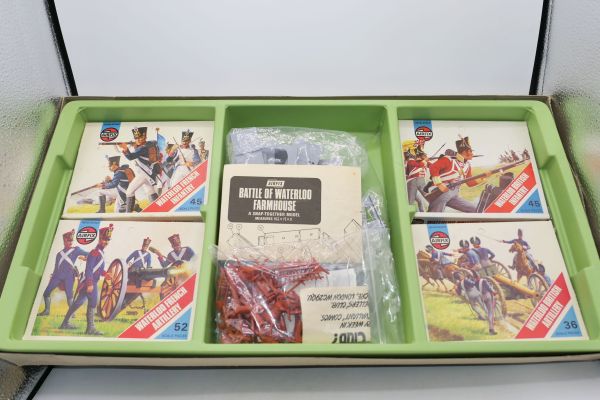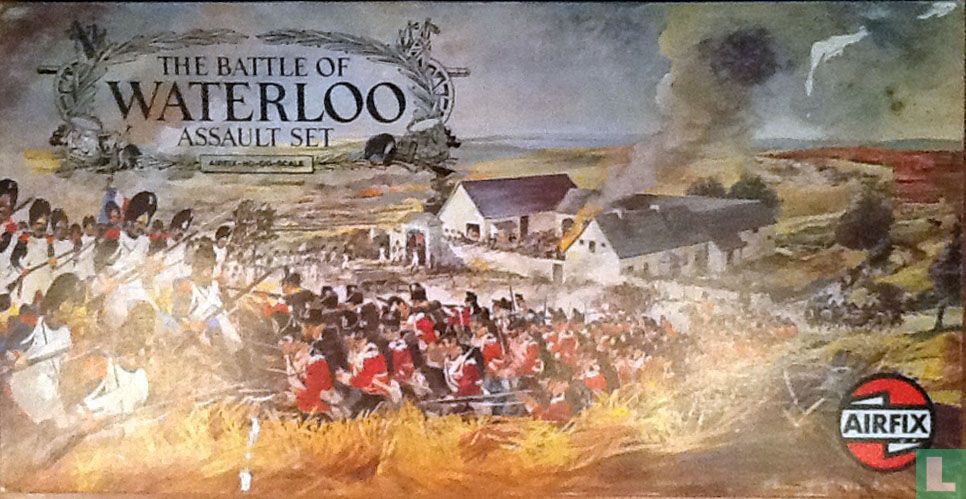Introduction
The Airfix Battle for Waterloo Assault Set transports hobbyists back to one of the most pivotal battles in European history—the Battle of Waterloo, fought on June 18, 1815. In this dramatic showdown, Napoleon Bonaparte’s French army faced the combined might of the Duke of Wellington’s Anglo-allied forces and General Blücher’s Prussian army. The outcome reshaped the political landscape of Europe and marked the definitive end of the Napoleonic Wars.

Airfix’s kit captures this epic struggle in 1:72 scale, offering enthusiasts a rich and immersive modeling experience. Whether you’re a historical wargamer, a scale modeler, or a student of military history, the Battle for Waterloo Assault Set provides the pieces to recreate a moment that defined an era.
Historical Context: The Battle of Waterloo
To appreciate the depth of the Airfix set, it helps to understand the historical weight of the event it depicts.
After escaping exile on Elba, Napoleon returned to France and rapidly regained power in 1815, initiating the Hundred Days Campaign. The European powers responded by forming the Seventh Coalition, determined to stop him once and for all. The decisive battle occurred near the Belgian village of Waterloo.
On June 18, 1815, Wellington’s Anglo-allied army held defensive positions while awaiting the arrival of Blücher’s Prussians. Despite multiple French assaults—including the massed cavalry charges of Marshal Ney and the final push by Napoleon’s Imperial Guard—the coalition forces stood firm. The Prussians arrived late in the afternoon, attacking Napoleon’s right flank and sealing his fate. The French army collapsed, and Napoleon’s dream of empire was extinguished.
The Airfix Battle for Waterloo Assault Set aims to dramatize this grand encounter with historically inspired figures, accessories, and terrain.
Set Contents
The Airfix Battle for Waterloo Assault Set typically includes a range of figures and accessories that allow builders to stage different parts of the battle. While versions may vary, a typical set includes:
1. Infantry Figures
- British Infantry: Red-coated soldiers in shakos with muskets, representing Wellington’s line infantry.
- French Infantry: Blue-coated French line or Imperial Guard units, some in marching and some in firing poses.
- Scottish Highlanders: Kilts, feather bonnets, and charging poses, adding a unique and colorful element.
- French Old Guard Grenadiers: Elite troops known for their bear-skin hats and disciplined formations.
2. Cavalry Units
- British Heavy Cavalry (Scots Greys or Dragoons): Charging with swords raised.
- French Cuirassiers or Lancers: Representing Napoleon’s shock cavalry, adorned with breastplates or Polish-style uniforms.
3. Artillery
- Field guns and cannons, including crews for both British and French sides. The set often includes limbers, caissons, and gunner figures with ramrods and linstocks.
4. Terrain Features
- Farmhouse or La Haye Sainte: A crucial strongpoint held by British troops throughout the battle.
- Walls and Fences: Provide cover and defensive positions.
- Flag Poles and Standards: French eagles or British colors to mark unit identity.
The figures are generally made of soft plastic, compatible with other 1:72 kits from Airfix or rival manufacturers. The poses vary—some in mid-battle, others marching, reloading, or wounded—bringing the scene to life.
Modeling and Painting the Set
For enthusiasts, part of the joy lies in painting and assembling the miniatures. Each army has distinct uniforms and colors, offering both challenge and reward to painters.
Painting the British Army
- Coats: Bright red with white crossbelts.
- Trousers: Gray, white, or dark blue depending on regiment.
- Shakos: Black with brass or colored plumes.
- Highlanders: Tartan kilts (green and blue) with red jackets.
Painting the French Army
- Coats: Dark or sky blue depending on unit.
- Pants: White for line infantry; dark blue for Guard units.
- Headgear: Shakos, bearskins (Old Guard), or metal helmets (Cuirassiers).
- Artillery: Green gun carriages with brass barrels.
Painted correctly, the miniatures can be museum-worthy, though beginners can also achieve excellent tabletop quality with basic techniques and washes.
Diorama Potential
The Battle of Waterloo offers immense opportunities for creating dramatic dioramas. Using the Airfix set as a base, hobbyists can design scenes that capture various aspects of the battle.
Diorama Scenarios
- Defence of La Haye Sainte: Position British riflemen behind stone walls, fending off French line infantry with mounted officers leading the charge.
- Cavalry Clash: Model a head-to-head charge between French Cuirassiers and British heavy dragoons.
- Imperial Guard Assault: Show the disciplined advance of Napoleon’s Old Guard toward Wellington’s lines, met by a final British volley.
- Blücher’s Arrival: Depict Prussian troops emerging from the right flank to relieve pressure and break Napoleon’s formations.
Adding scenic elements like grassy fields, mud trails, gun emplacements, and trees helps bring the diorama to life. Some modelers even use cotton wool or LED lighting to simulate cannon smoke and musket fire.
Historical Accuracy and Appeal
Airfix has long been praised for blending model-making with history education. The Battle for Waterloo Assault Set exemplifies this balance.
Accuracy
The uniforms, weapons, and formations are based on historical records and battlefield accounts. While some compromises exist for simplicity, the overall aesthetic remains faithful to the early 19th-century period.
Modelers who want to enhance accuracy can research the actual regiments present at Waterloo, including the King’s German Legion, the 95th Rifles, and the Nassau troops on the Allied side, and the I and II Corps of the French army.
Wargaming Compatibility
Beyond display, the Waterloo Assault Set is ideal for Napoleonic wargaming. The 1:72 scale fits well with common tabletop rulesets such as:
- Black Powder (Warlord Games)
- Napoleon’s Battles
- Shako
- De Bellis Napoleonicis
With slight modifications, the Airfix figures can be organized into regiments and battalions, complete with artillery batteries and cavalry charges. Their soft plastic makes them more forgiving in gameplay, though some hobbyists prefer rebasing them for easier movement.
Educational Use
This set is a powerful teaching tool for illustrating:
- Napoleonic tactics (square formation, column attacks, artillery barrages)
- Geopolitical impact of the Battle of Waterloo
- Uniforms and equipment of early 19th-century armies
- Military engineering, with field fortifications and artillery placement
History educators can use the set in classroom demonstrations, while homeschoolers may find it an engaging way to teach the Napoleonic era.
Expansion and Customization
Modelers often expand the Airfix Waterloo set by incorporating figures from other kits:
- Prussian Infantry (from HaT or Italeri)
- Dutch-Belgian troops
- Additional artillery and cavalry units
Conversions are also possible: figures can be modified with green stuff or plasticard to represent officers, musicians, or standard bearers. Dioramas can also include casualties, smoke effects, or even sound modules for added immersion.
Conclusion
The Airfix Battle for Waterloo Assault Set is much more than a box of plastic soldiers—it’s a doorway into one of history’s greatest battles. From painting the vibrant uniforms to assembling detailed dioramas and re-enacting strategic movements, the set offers historical depth and creative satisfaction.
For hobbyists new to Napoleonic warfare or seasoned veterans seeking to relive the climax of the age of empire, the Airfix Waterloo set delivers a compelling mix of storytelling, craftsmanship, and history. Whether as a standalone display, part of a sprawling diorama, or a wargaming force, this set brings the echoes of Waterloo to your tabletop in vivid miniature.

